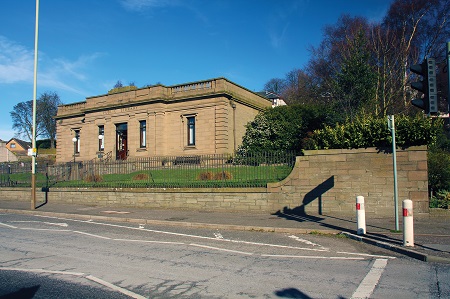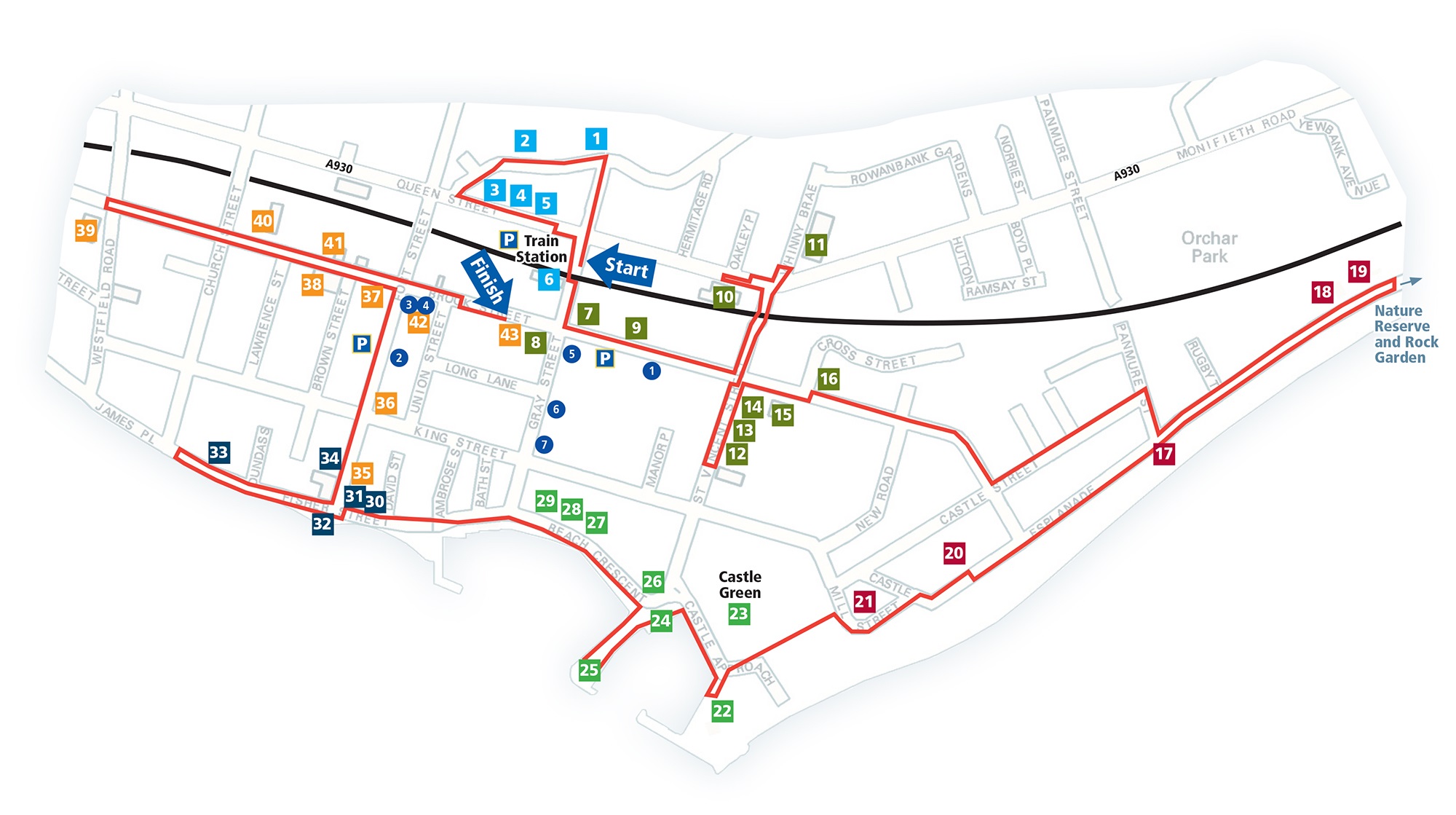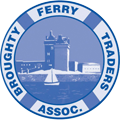Broughty Ferry Walk
An amazing walk of discovery
Broughty Ferry presents a neat and clean appearance; and from the river, the view of the village in front, with the villas of the more wealthy on the sloping background, is very picturesque.
This walking tour is mainly focused on central Broughty Ferry within a section of the gridiron street plan of Colonel Charles Hunter’s New Town bounded by Queen Street, St Vincent Street, King Street and Church Street. After 1801 the town grew, providing houses, shops and services, but it was the coming of the railway in 1838 from Arbroath to Dundee that determined its development. With no major industries, Broughty became a commuter satellite of Dundee. It already had a reputation for sea bathing for wealthy visitors, but regular train services and a range of fares now made it a holiday resort for many from Dundee and beyond. Soon wealthy Dundee businessmen also saw the attractions of the area and built their fine mansions on the slopes above the town.
Other important areas had existed long before the “new town” developed. For centuries ferries had provided an important link across the Tay, and the expansion of the railways gave a new lease of life to the service. The Castle also had a long history. Built in 1496 by Lord Gray, it was attacked and occupied in various struggles, and eventually abandoned in the mid 17th century. A ruin for almost 200 years, it was purchased and restored by the War Office when fears of invasion arose in the mid 19th century. The military presence remained until the end of the Second World War. Another long established community was that of the fisher folk, concentrated in and around Fisher Street. It developed somewhat apart from the rest of Broughty Ferry, with its own traditions and customs.
Take a walk through Dundee's past

Broughty Ferry Train Station

Broughty Ferry public library
Sections
- Full Map
-
Queen Street Area
A circular walk from the station via Gray Street, Camphill Road and Queen Street features some later building on the slopes beyond the railway, which initially threatened to cut this area off from the main centre.
-
Brook Street (East)
As we walk east along Brook Street, shops and businesses give way to houses in a range of sizes and styles. Some side streets still have the original enamel signs. A proposal in 1825 to extend Hunter’s original planned development beyond Castle Street did not materialize.
-
The Esplanade and Beach
This area was not included in Hunter’s plan, being part of the Dalhousie estates. Sea-bathing in the later 18th century led to the popularity of places such as Broughty Ferry. The later influx of visitors and the growth of leisure activities led to the burgh being described as “the Brighton of the North”.
-
Castle, Harbour and Beach Crescent
Walk towards the Castle, past modern day leisure facilities. Broughty Castle is still a dominant landmark and information panels outline its history. The quiet Harbour belies its former importance as a key gateway before the building of bridges. Beach Crescent has a pleasant collection of houses in various styles from the late 18th to the 20th centuries.
-
Fisher Street
Some of the fishermen’s houses and cottages are amongst the oldest buildings in Broughty Ferry. Commercial fishing by sailboats using long lines was mostly for white fish; herring fishing with drift nets was seasonal. The fishing industry peaked in the 1880s with 80 boats and over 180 men involved.
-
Fort Street to Brook Street
Fort Street (formerly named Fort Aboukir Street, after Nelson’s victory in the Battle of Fort Aboukir Bay at the mouth of the Nile in 1798) leads back to Brook Street, the main shopping area and the centre of the town.

Queen Street Area
At the top of Gray Street stands the Lodge for the former Carbet Castle, topped with a dragon weather vane, and showing the Grimond family emblem – a camel. A stone version of this animal surmounted the entrance to Grimond’s Bowbridge Works in Dundee.
2Carbet Castle once dominated the area but was replaced in 1998 by a block of flats with the same name which echoes the Gothic style of the former mansion. Joseph Grimond, a wealthy jute manufacturer, bought Kerbet House in the 1860s, enlarged and renamed it, creating one of the many fine mansions in the area.
The former church, opened in 1876 as Queen Street United Presbyterian Church, was one of many built around this time to cater for the rapidly growing population. The congregation amalgamated in 1953 with St Luke’s Church and the building later became a restaurant.
4The Gardener’s Cottage was part of the Grimond property. Large houses employed both indoor and outdoor staff and tied cottages were often provided for gardeners and coachmen.
The Library, built in the style of the Petit Trianon at Versailles, was completed in 1928 as part of the agreement made by the City of Dundee at the annexation of the Burgh in 1913.
6The Railway Station (1838) is one of the oldest in Scotland and although restored on several occasions still has many of its original features, including the redundant signal box, now re-erected next to the southbound platform.
Train Station
Brook Street (East)
The Royal Arch is a public house dating from the 19th century, which might take its name from either a nearby Masonic lodge or the stone arch erected in Dundee harbour to mark the visit by Queen Victoria in 1844. Note the interesting stained glass windows with local scenes.
8Goodfellow & Steven Bakers shop (opposite in Gray Street) founded in 1897 is one of the few continuing family businesses. The shop front and attractive hanging sign date from a 1920s refurbishment. Founder David Goodfellow was a talented artist and some of his paintings hang in the tea room.
9At 329 Brook Street there is a tiled entrance, one of the few remaining in Broughty Ferry.
The New Kirk (left under the railway bridge at the top of St Vincent Street) was originally the East Free Church, built in 1865 to the design of Andrew Heighton, and was described at the time as “the handsomest Presbyterian church of its size that we have yet seen in Scotland”. It attracted some outstanding ministers, including the Rev James Moffatt, renowned for his modern translation of the Bible. It became Broughty East Church in 1929 and the congregation joined with St Aidan’s Church in 2005 to form the New Kirk.
The former Eastern Primary School (opposite) was completed in 1911 in Art Nouveau style by Langlands and Lamond, replacing the earlier school at the other end of St Vincent Street.
12Walk back down St Vincent Street to The Baptist Church, founded in 1876. The congregation met in private houses before the building, designed by J H Robertson in the Arts and Crafts style, opened in 1881.
The former Eastern Public School was taken over by St Aidan’s as a church hall and now accommodates an undertaker’s business.
14St Aidan’s Church, formerly the parish church, opened as a Chapel of Ease in 1826 and became a church in its own right in 1863. It contains windows by Burne-Jones/William Morris. Recently re-modelled inside, it is now a social centre, with a place of worship upstairs.
15The Memorial to Thomas Dick is left of the entrance, alongside the railings. He was an early astronomer and Christian philosopher and a supporter of the Anti-Slavery movement.
16Cross Street, with its cobbled surface, was once the entrance to a railway goods yard. Further along, where the street bends right, a branch line used to cross over the road on a bridge and go round Castle Green to the Harbour.
The Esplanade and Beach
The Esplanade has attractive late 19th century stone-built houses, many with double bay windows, overlooking the beach. Note dates on some guttering. The sand dunes are a recent feature.
18Eastcott was for the last twenty years of his life the home of Sir Francis Mudie. Born in Broughty Ferry, he had a distinguished career in the Indian Civil Service, culminating in his being asked to continue as interim governor of West Punjab from 1947 to 1949.
The Glass Pavilion, formerly an Art Deco bathing shelter (1934) and now a restaurant, is the only surviving amenity, now that the Bandstand and Swiss Chalet style tea room have gone. [You can extend your walk eastwards to the Nature Reserve and the Rock Garden.]
20Retrace your steps to Castle Terrace, a fine row of 1860s houses, many with original features and gardens, fronted by a public park. Note the plaque inside the south wall to rugby international Colin MacDonald Gilray.
A five-sailed Windmill which once stood here gave its name to Mill Street and Windmill Park. Note the sail-shaped flower beds. It powered an adjacent joiner’s workshop making domestic items and toys. There is a model of the Mill in the Castle.
Castle, Harbour and Beach Crescent
Walk to the Castle, now a Museum with displays on local history and wildlife, and a selection of Provost Orchar’s art collection. Its gateway, gun mounts and narrow window slits are reminders of its military past.
23Castle Green Play Area was once used for military exercises.
24The Harbour was built for the railway along with a similar one at Tayport. From 1851 goods could take advantage of Thomas Bouch’s “flying bridges” and go directly on to the ferry – an early roll-on/roll off facility. Passengers disembarked on the west side of the pier.
On the pier is the HQ of the Amphibious Ancients, established as a swimming club in 1889 and noted for its New Year’s Day “Dook”.
26The Red House, on the corner of Beach Crescent and St Vincent Street (named after the naval victory in 1798) was built for colonel Charles Hunter.
27The Orchar Nursing Home was built as a private residence and later housed Provost Orchar’s art collection, until the need for building restoration saw the collection moved to Dundee’s Art Gallery. An unusual “barley sugar” lamp stands at the entrance.
The elegant Lamp-standards lining the Crescent date from the days of the former Burgh. Recently restored and showing the Burgh coat of arms, they are an interesting link with the past.
29Another fine house, now a care home, stands at the corner of Gray Street. Also owned by the Hunter family, it has an impressive fanlight above the door.
Fisher Street
The Ship Inn is an old public house, formerly a shop. Here you can hire the key to the Old Graveyard.
31Barometer Cottage is named after the cased barometer, installed in 1859. Its readings saved the Ferry fishing fleet from a disaster in 1881.
Lifeboat was originally sited at Budden Ness. In December 1959 the lifeboat Mona was lost with her crew of 8 in a severe easterly gale. See details on the plaque. This Station is now one of the busiest in Scotland.
St James’ Church, designed by T S Robertson and opened in 1890, had its origins in a Mission for the fisher community.
33The Old Graveyard dating back many centuries is a “must” for visitors. Information boards in Fisher Street and inside the graveyard give details of its contents and history (key available from The Ship Inn).
Fort Street to Brook Street
The Fisherman’s Tavern was originally the Buckie Tavern, named after whelks or “buckies” found on the shore. Note the Johnstone plaque by the door, and the atmospheric interior.
36The Eagle Coaching Inn is another old established public house where the Dundee stage coach stopped daily. The wooden eagle over the south doorway was carved in 1860 by James Law, better known for his whaling ship figureheads.
37The Masonic Hall at 152 Brook Street was completed in 1911 to a design by F and H Thomson, sons of James Thomson the outstanding Dundee architect.
The Municipal Building, including The Burgh Halls and Police Station, was the focal point of local government until 1913. Note the wrought iron arch and clock. The Burgh Regalia are in the Castle Museum.
39St Stephen’s Church is further west on the south side of the street. Designed by leading architect T S Robertson and completed in 1871, it has fine stained glass windows by Burne-Jones/William Morris. The spire, struck by lightning in 2011, was recently restored.
40The Congregational Church, on the north side of the street, now offices, was opened in 1865. From the 1820s the congregation was served by a chapel nearby in Haldane Lane. John Methven, who gave money for the building, has a family memorial in the Old Graveyard.
The YMCA Building played an important role in the Burgh, at one time providing a school and a place of worship.
42Moving back eastwards on the south side of the street, one finds Gillies the furniture shop, another long established family business, at one time also auctioneers and funeral directors. Inside the store is an old Broughty Provost’s lamp.
43McDonald the Stationers, formerly Bowmans, also has a long history. Alexander Bowman, a former press reporter, opened his newsagent, stationery shop and printing works in the 1870s, and was responsible for publishing an Illustrated Guide to Broughty Ferry, as well as a Broughty Ferry Annual for over 20 years.
Summer in Broughty Ferry
Introduced 100 years ago, The Broughty Ferry Gala Week is staged annually during the first week of July and has become the area’s foremost Summer festival. The extensive week-long programme of events for children and adults is organised and run by local traders and includes a traditional Fête and many very popular activities and entertainment for all the family in locations throughout the town.
Festive Fun
The Broughty Ferry Christmas Lights Concert is held at the end of November when the town’s Christmas Lights display is switched on by The Lord Provost of Dundee. Sponsored by the local traders who purchase and ceremonially gift the lights to the townspeople of B roughty Ferry, this popular family event welcomes in the festive season and includes live music and carol singing, street entertainment, carnival rides and of course Santa! Many of Broughty Ferry’s boutiques and cafés remain open until late.
To find out more about these events visit www.cometobroughty.co.uk
Broughty Ferry Traders’ Association
The Broughty Ferry Traders’ Association was founded in the early 1900’s ‘to foster and promote trade and business within Broughty Ferry and to maintain and increase the amenities of the area.’ The Traders Association has played an important role in Broughty Ferry’s past and continues to do so today. The BFTA are proud to sponsor The Broughty Ferry Heritage Walk.
To find out more about Broughty Ferry visit www.cometobroughty.co.uk
Broughty Ferry Community Council
Broughty Ferry Community Council has a long history of service to the people of Broughty Ferry. For four decades the Community Council has reflected the views of the community and promoted the interests of Broughty Ferry as a whole. Recent initiatives include the development of our dedicated web site www.broughtyferrycommunitycouncil.org and the publication of a booklet – The Memory of Broughty Ferry – which contains essays written to mark the centenary of the annexation of the former Burgh of Broughty Ferry into the City of Dundee. Copies are available at Eduardo Alessandro Studios, McDonalds the Stationers and Broughty Castle.

